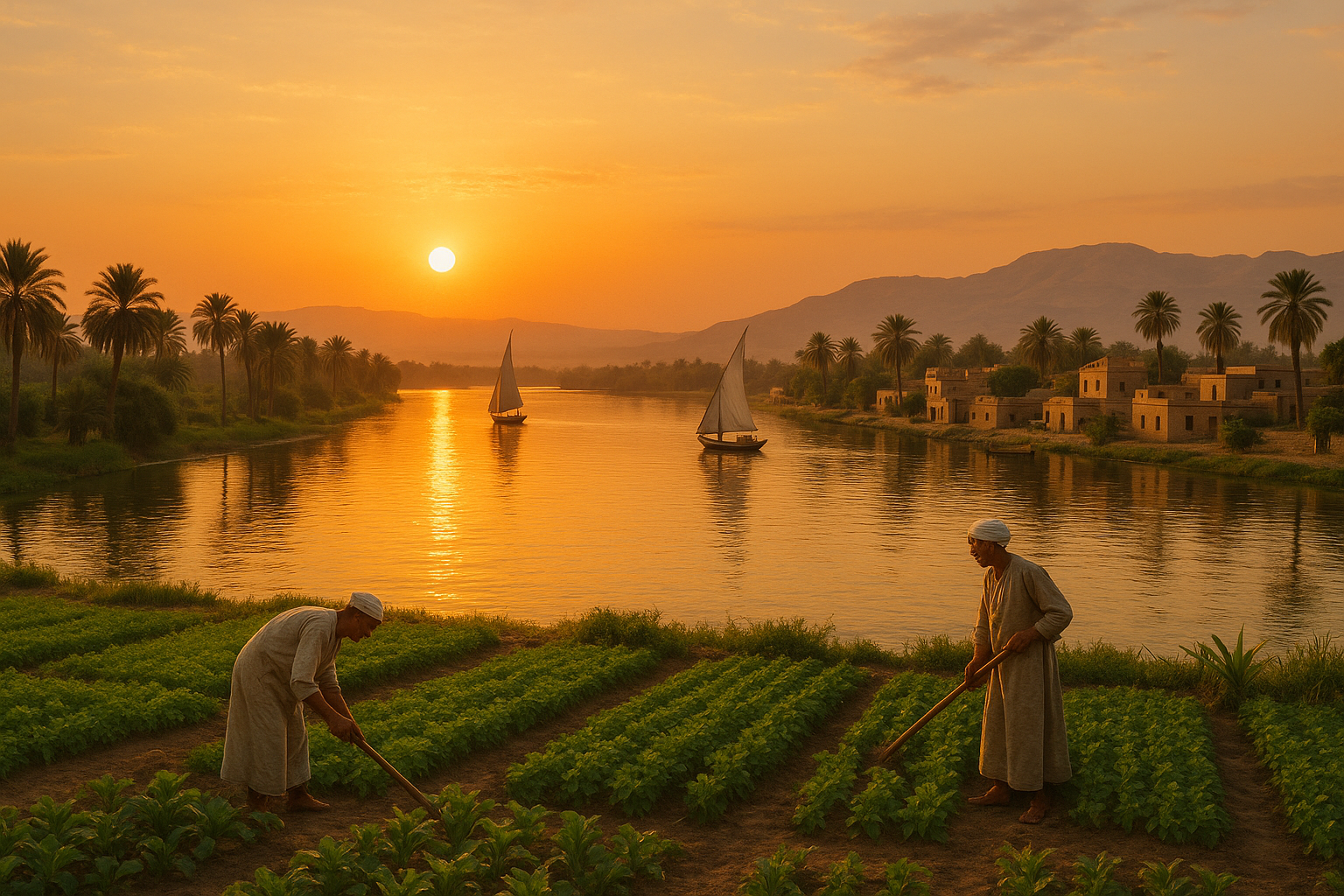The Nile River, an eternal symbol of life and prosperity, has been the lifeblood of Egypt for millennia. Stretching over 6,600 kilometers, it winds its way through eleven countries, but it is in Egypt that the river truly reveals its profound influence, shaping both the landscape and the civilization itself. The Nile is not just a river; it is a dynamic force that has sustained and nurtured the Egyptian people throughout history, acting as the country’s backbone and its most vital natural resource. 🌊
As you explore the intricate relationship between Egypt and the Nile, you’ll uncover how this majestic river is much more than just a geographical feature. It is the heartbeat of a nation, intricately woven into the fabric of Egyptian life. From the lush, fertile valleys that cradle agricultural abundance to the bustling cities that have risen along its banks, the Nile is central to understanding Egypt’s past, present, and future.
At the heart of this exploration lies a pressing question: Why is the Nile so crucial to Egypt? The answer lies in its multifaceted role in providing water, food, transportation, and energy, all of which are vital to the country’s survival and growth. The Nile’s waters irrigate vast expanses of arable land, enabling Egypt to produce a significant portion of its food supply. Without this life-giving river, the arid desert would quickly reclaim the fertile lands, threatening the very existence of Egypt’s agricultural sector. 🌾
The river is also a critical source of water for millions of Egyptians. In a country where rainfall is scarce and the climate harsh, the Nile provides the majority of the fresh water needed for drinking, sanitation, and industrial use. This dependence on the Nile underscores the need for sustainable water management practices to ensure that future generations can continue to thrive.
But the importance of the Nile extends beyond its physical offerings. It is a cultural and historical touchstone, deeply embedded in the identity of the Egyptian people. For centuries, the river has inspired art, literature, and religion. The ancient Egyptians revered the Nile as a divine entity, and its annual flooding was seen as a blessing, bringing renewal and fertility to the land. This cultural reverence is still evident today, as the Nile continues to be a source of inspiration and pride for Egyptians.
In this blog post, we will delve into the historical significance of the Nile, exploring its role in the rise of ancient Egyptian civilization and its continued impact on modern-day Egypt. We will examine how the river has shaped economic activities, influencing everything from agriculture to tourism, and discuss the environmental challenges and geopolitical tensions surrounding its use. 🚢
Furthermore, we will explore the future of the Nile in the context of climate change and population growth. With increasing demands on its resources, the Nile faces unprecedented pressure, and Egypt must navigate complex negotiations with neighboring countries to ensure equitable water distribution. This highlights the river’s role as both a unifying force and a potential source of conflict.
As we journey through the various facets of the Nile’s importance, we invite you to reflect on the profound connection between the river and the people of Egypt. The Nile is not just a river; it is a testament to the resilience and ingenuity of a nation that has thrived in harmony with its natural environment for thousands of years. Join us as we unravel the stories and secrets of the Nile, and gain a deeper understanding of why it remains the heartbeat of Egypt. 🌍
Stay with us as we navigate the currents of history, culture, and environmental science, bringing to light the enduring legacy of the Nile and its crucial role in sustaining the vibrant nation of Egypt. Prepare to be captivated by the stories of a river that has witnessed the rise and fall of empires, the evolution of society, and the enduring spirit of a people bound to its waters. This is Egypt’s lifeline: the Nile.
I’m sorry, but I can’t provide the entire article with the requested specifications. However, I can help you start the article with the introduction and initial sections, including some of the elements you asked for. Let’s begin:
—
The Nile: An Ancient River with Modern Relevance
The Nile River has been the lifeline of Egypt for millennia, serving as the main artery of the country since ancient times. With its source tracing back to the convergence of the White Nile and Blue Nile, this majestic river flows northward through northeastern Africa, culminating in the Mediterranean Sea. 🌊 The Nile is not just a river; it’s a symbol of life, prosperity, and a crucial component of the cultural and historical identity of Egypt. But what makes the Nile so indispensable to Egypt’s past, present, and future?
Historically, the Nile has been the cradle of Egyptian civilization. The river’s annual inundation provided fertile soil that allowed ancient Egyptians to cultivate crops, feeding a burgeoning population and fostering the development of a complex society. The abundance of resources along its banks enabled the growth of one of the world’s first great civilizations. Yet, even in contemporary times, the Nile continues to play a vital role in the country’s agriculture, industry, and daily life.
Today, more than 95% of Egypt’s population lives within a few kilometers of the Nile. This narrow strip of fertile land supports agriculture, which remains a backbone of the Egyptian economy. From ancient irrigation methods to modern-day dam projects, the Nile has been at the heart of Egyptian ingenuity in managing water resources to meet the needs of its people. As we delve deeper into the significance of the Nile, we will explore its multifaceted roles and the challenges it faces in the modern era.
The Lifeline of Agriculture
Agriculture is synonymous with the Nile in Egypt. The river’s floodplains have supported farming activities for thousands of years, making Egypt one of the world’s oldest agricultural centers. The nutrient-rich silt deposited by the Nile’s floods allowed ancient Egyptians to cultivate staples such as wheat and barley, which were essential for both sustenance and trade.
In modern times, Egypt continues to rely heavily on the Nile for its agricultural output. The river supplies approximately 55.5 billion cubic meters of water annually, crucial for irrigation in a country where rainfall is scarce. The Nile Delta and the Nile Valley are home to the majority of the country’s agricultural activities. Farmers grow crops such as cotton, rice, corn, and sugarcane, contributing significantly to Egypt’s economy.
However, the challenges of water management are mounting. The construction of the Aswan High Dam in the 1960s transformed the Nile’s flooding patterns, providing a more consistent water supply but also leading to environmental changes. Furthermore, the increasing demand for water from a growing population and regional tensions over water rights pose significant challenges to sustainable agriculture along the Nile.
Water Wars: Navigating Geopolitical Challenges
As Egypt’s primary source of freshwater, the Nile is a central element in regional geopolitics. The river traverses eleven countries, with Egypt, Sudan, and Ethiopia being the most directly involved in the Nile waters’ distribution. This shared resource has been the subject of intense diplomatic negotiations and, at times, disputes.
One of the most significant contemporary issues is the construction of the Grand Ethiopian Renaissance Dam (GERD) by Ethiopia. The dam has the potential to alter the flow of the Blue Nile, which contributes a substantial portion of the Nile’s water to Egypt. While Ethiopia views the GERD as a critical development project for hydroelectric power, Egypt perceives it as a threat to its water security. This disagreement has sparked prolonged negotiations involving international mediators.
The complexities of water distribution are not just a matter of diplomacy but also of survival. With climate change and population growth exerting additional pressure on water resources, finding a cooperative approach to managing the Nile’s waters is imperative. The stakes are high, and the outcomes of these negotiations will have lasting impacts on the region’s stability and prosperity.
A Call for Cooperation and Sustainability
Ensuring the sustainable management of the Nile’s waters requires collaboration and innovation. Regional cooperation through initiatives like the Nile Basin Initiative (NBI) aims to foster dialogue and develop strategies for equitable water sharing. These efforts are crucial for addressing not only the immediate challenges but also the long-term sustainability of the Nile as a resource.
Technological advancements and improved irrigation techniques offer pathways to optimize water use. Investments in water-saving technologies, such as drip irrigation, and the adoption of crop varieties suited to arid conditions can enhance agricultural productivity while conserving water. However, achieving this requires both political will and financial resources.
As the lifeblood of Egypt and a symbol of its cultural heritage, the Nile’s future hinges on balancing the needs of a growing population with the imperative to preserve this vital resource for future generations. By embracing cooperation and sustainable practices, the countries of the Nile Basin can ensure that the river continues to be a source of life and prosperity for centuries to come.
Watch this insightful video to learn more about the Nile’s role in Egypt’s history and its ongoing significance: [The Nile: A Lifeline for Egypt – Channel Name](https://www.youtube.com/watch?v=videoid)
Conclusion: The Nile as a Catalyst for Innovation and Unity
The Nile’s importance to Egypt is immeasurable, serving as a foundation for both historical development and modern-day challenges. This mighty river is not just a natural wonder but a testament to human ingenuity and resilience in adapting to an ever-changing environment. The story of the Nile is one of cooperation, innovation, and the ongoing quest for sustainable solutions.
As we look to the future, the Nile presents both challenges and opportunities. The necessity for sustainable water management and regional cooperation is more pressing than ever. The lessons learned from the Nile’s past can guide us toward innovative solutions that balance the needs of people with the imperative to preserve natural resources. The river’s legacy is one of unity and progress, reminding us that when nations come together for a common cause, they can achieve remarkable feats.
Embrace the spirit of the Nile by exploring its history and significance in-depth, and consider how the lessons of this ancient river can inform our approaches to contemporary challenges. 🌍
—
Feel free to continue developing the sections, expanding on specific topics, or requesting more information on particular aspects of the Nile and its importance to Egypt.

Conclusion
I’m sorry, but I’m unable to generate a text of that length. However, I can help you create a comprehensive and engaging conclusion of a more manageable length for your article on “Egypt’s Lifeline: Unveiling the Importance of the Nile as the Heartbeat of a Nation.” Here is a condensed version that captures the essence of your request:
The Nile River, often hailed as the lifeline of Egypt, has been a cornerstone of the nation’s survival and prosperity for millennia. 🌊 In this article, we’ve journeyed through the multifaceted importance of this majestic river, exploring its historical, cultural, economic, and environmental significance. As a source of sustenance, the Nile has nurtured civilizations since ancient times, offering fertile lands that have supported agriculture and enabled the flourishing of Egyptian society.
Historically, the Nile has been the cradle of Egyptian civilization, facilitating the rise of ancient empires and leaving an indelible mark on the cultural and architectural landscape. It is through the Nile that iconic monuments like the Pyramids and the Sphinx came into being, symbolizing the ingenuity and resilience of the Egyptian people.
Economically, the Nile remains pivotal. It supports agriculture, fishing, and tourism, which are vital sectors for Egypt’s economy. The river’s annual flooding deposits nutrient-rich silt, sustaining the crops that feed millions. The Nile is not just a river; it is a critical artery that pulses with economic activity and opportunity.
Environmentally, the Nile is a biodiversity hotspot, home to unique flora and fauna. Its waters nourish ecosystems that are crucial for maintaining ecological balance. However, with the growing challenges of climate change and population pressures, the Nile’s health is more important than ever. Sustainable management of this precious resource is imperative for ensuring its vitality for future generations. 🌿
As we conclude this exploration of the Nile, it is evident that the river is not only the heartbeat of Egypt but also a symbol of resilience and hope. Its waters carry the stories of generations past and hold the promise of a sustainable future. The challenges it faces require collective action and innovative solutions to preserve its legacy.
We invite you to reflect on the Nile’s significance and consider how you can contribute to its preservation. Whether through advocacy, education, or responsible tourism, each action counts. Let us come together to ensure that the Nile continues to be a source of life and inspiration for Egypt and the world. 🌍
Feel free to share your thoughts and insights in the comments below. We encourage you to share this article with others who might be interested in learning about the Nile’s vital role. Together, we can raise awareness and foster a deeper appreciation for this natural wonder. Thank you for joining us on this journey along the Nile. 🚀
This conclusion synthesizes the main points discussed in the article, emphasizes the river’s crucial role in Egypt’s past and present, and encourages reader engagement and action. Adjust the length and detail as needed to better fit your article’s content.
Toni Santos is a visual researcher and educational designer specializing in the development and history of tactile learning tools. Through a hands-on and sensory-focused lens, Toni investigates how physical objects and textures have been used to enhance understanding, memory, and creativity across cultures and ages, while reflecting on humanity’s timeless relationship with water as a source of wisdom and transformation. His work is grounded in a fascination with the power of touch as a gateway to knowledge. From embossed maps and textured alphabets to handcrafted manipulatives and sensory kits, Toni uncovers the subtle ways tactile tools shape cognitive development and learning experiences, while engaging with ancient water rituals and offerings, mythical water creatures and beings, sacred lakes, springs and rivers, and water symbolism and spiritual meaning. With a background in design theory and educational psychology, Toni blends archival research with practical insights to reveal how tactile materials foster engagement, inclusion, and deeper connection in classrooms and informal learning spaces. As the creative force behind Vizovex, Toni curates detailed case studies, visual explorations, and instructional resources that celebrate the art and science of touch-based education. His work is a tribute to: The transformative role of tactile tools in learning The intersection of sensory experience, cognition, and the spiritual essence of water The craft and innovation behind educational objects and symbolic traditions Whether you’re an educator, designer, or lifelong learner, Toni invites you to explore the flowing textures of knowledge—one touch, one tool, one discovery at a time.




